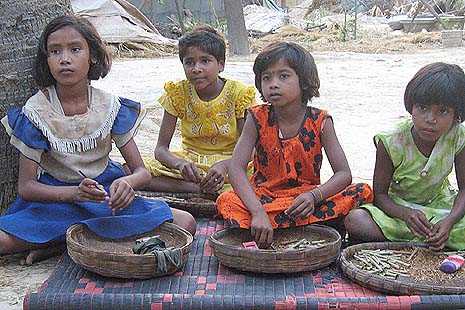
Rohan Kumar, an 11-year-old boy, sits outside a private doctor’s clinic coughing and spitting blood. He has contracted tuberculosis after working as a painter for the past two years. Chapped fingers and bent back characterize Soni Devi, who works as a maid. She is barely 12 years old. She cooks, looks after twin infants and does all the household chores. Her day begins at 5 am and ends at 10 pm. School is a distant dream. Despite working more than 17 hours a day, her meagre earnings are not enough to feed her alcoholic father and five younger siblings. Sunday June 12 was anti-child labor day. Symbolic celebrations are held on this day every year but nothing concrete has been done by successive governments so far to eradicate the menace. Despite a plethora of legislation and scores of NGOs working against it, child labor remains rampant in the country. India accounts for the second highest number of child laborers in the world. It is home to close to 13 million laborers under 14 years of age, according to a 2001 census. Child laborers working hard is a common spectacle, be it in homes, wayside eating joints, small restaurants or factories. They are everywhere but invisible, toiling as domestic servants, laboring behind the walls of workshops or hidden from view in the confines of their own homes. The most common kind of exploitation of child labor is found in poor homes. Factories, cracker and bidi (a leaf-rolled Indian cigarette) manufacturers successfully circumvent the anti-child labor law by employing children in their own homes. The constitution prohibits children below 14 years from working and the law bans child labor, however, children continue to work in home-based industries, says Binoy Mathews, communications officer at the Voluntary Health Association of India. The bidi industry prefers to engage children as their nimble fingers are more adept at rolling bidis and they can also be easily exploited. There are hundreds of such cases in Murshidabad in West Bengal, he says. These children are constantly exposed to hazardous chemicals and tobacco dust, which causes them to suffer from TB, postural and eye problems, anemia, skin and lung problems and other diseases, says Mathews. Father Jose Kuriakose runs an NGO, V Care, at Jehangirpuri, a slum in northeast Delhi. He says the area is notorious for child labor. These young laborers, many of whom are yet to lose their milk teeth, are doing back-breaking work in the confines of their homes such as garbage collection and sorting and the like. Hundreds of children work in the huge garbage dumps at Jehangirpuri. Their worn out hands, which look worse than those of people in their eighties, are a testimony to their toil. They set out at 2am and early morning they can be seen returning from the dump, sometimes badly bruised. Very often there are injuries caused by glass pieces, chemicals and even explosives. But nothing deters these street smart kids, who even as young as five years old take to drugs, solvents and other harmful substances, he says. They can be seen looking for solvent bottles, ripping them open and then sniffing the contents. Some of them sit for hours sorting garbage to keep fires burning, says Sandra Willmer, field officer in charge of V Care. The sound of coughing reverberates in the area. Men, women and children sort out garbage and inhale all kinds of chemicals in the process. Small children who do the job are worst hit, she says. An estimated 20 percent of domestic workers are children below 14, says the Catholic Bishops’ Conference of India’s Commission for Labor. Millions of girls who work as domestic servants are especially vulnerable to exploitation and abuse. The case against child labor in the bidi industry is currently in the Supreme Court and Mathews says he can only hope something good comes out of it. Related reports Church Wants Catholics To Fight Child Labor, Starting With ThemselvesChurch Groups Work In Various Ways To Combat Child Labor


